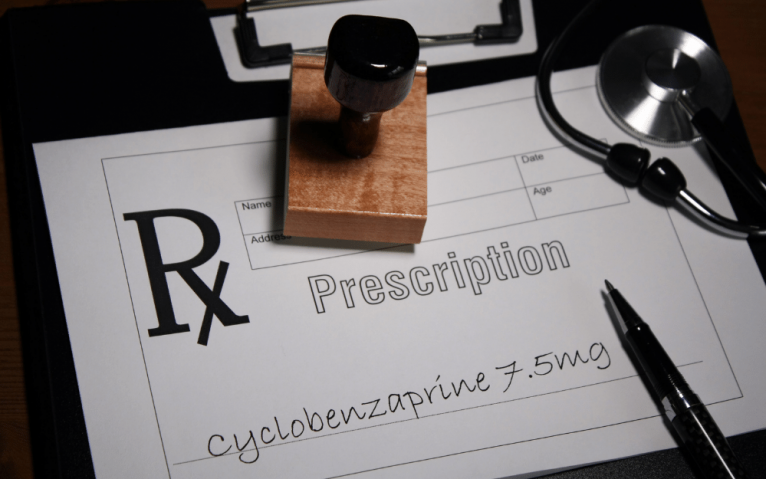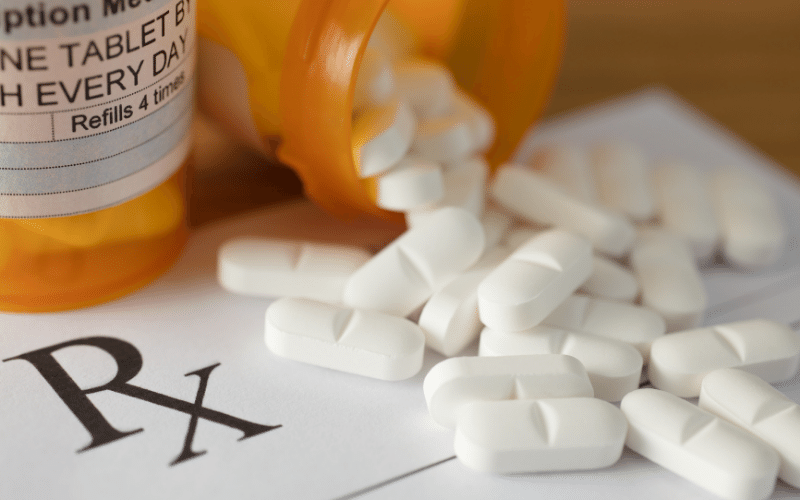Cyclobenzaprine (Flexeril) is a common prescription drug primarily used as a muscle relaxant to treat pain caused by muscle spasms. Part of the antidepressants family, cyclobenzaprine addiction is relatively common. Although it should be used as a short-term treatment, cyclobenzaprine can be highly addictive because it acts directly on the central nervous system, essentially blocking pain sensations. Let’s talk about everything you need to know about cyclobenzaprine addiction.
What is Cyclobenzaprine?
Cyclobenzaprine is a prescription drug and muscle relaxant that helps with muscle spasms. It’s also used in the treatment of fibromyalgia. This drug affects the central nervous system to block feelings of pain. It’s available in tablets, capsules, and powder. Although it isn’t a controlled substance, it does have the potential for misuse and abuse.
Brand names for cyclobenzaprine include:
- Flexeril
- Amrix
- Fexmid
- FusePaq Tramadol
Furthermore, on the streets, cyclobenzaprine can be found as:
- Flexies
- Cyclone
- Mellow yellow
Cyclobenzaprine Abuse by the Numbers
Over 54 million people ages 12 and up have abused a prescription drug at least once in their lifetime, according to the National Institute on Drug Abuse (NIDA). According to NIDA, young adults between the ages of 18 and 25 are among the primary abusers.
However, the Substance Abuse and Mental Health Services Administration (SAMHSA) reports that prescription drug abuse increases more among the older adult population ages 50 and over. This occurs even when cyclobenzaprine is not often prescribed to this population group.
In 2011, physicians across the country issued 25.2 million prescriptions for Flexeril and other medications with cyclobenzaprine. Within the last five years, emergency room visits related to muscle relaxant abuse doubled, increasing almost 101%.
Signs of Cyclobenzaprine Addiction
Because of the way cyclobenzaprine works, many people who take the drug are at risk of addiction. In 2016, out of 5.2 million with a Flexeril prescription, almost 5% of those users abused it at least once.
Common signs of cyclobenzaprine addiction include:
- Being unable to stop cyclobenzaprine use despite efforts
- Experiencing cyclobenzaprine withdrawal symptoms when the drug’s effects wear off
- Taking more frequent or higher doses than prescribed
- Using cyclobenzaprine with other drugs or alcohol to enhance its effects
- Pretending to lose prescriptions to get early refills
- Participating in doctor shopping
- Faking symptoms to get more cyclobenzaprine prescriptions
- Using cyclobenzaprine for longer than prescribed
- Spending too much time thinking about the effects of cyclobenzaprine
Side Effects of Cyclobenzaprine Abuse
Overall, the effects of cyclobenzaprine can really help someone struggling with pain from muscle spasms. It can improve sleep, motor skills, and energy levels while providing pain relief at the same time. However, when misused or abused, it can lead to many side effects, including:
- Drowsiness
- Dry mouth
- Fatigue
- Headaches
- Dizziness
- Nausea
- Constipation
- Blurred vision
- Acid reflux
- Abdominal pain
- Nervousness
- Fever
- Urination problems
Cyclobenzaprine Abuse and Overdose
Someone who’s misusing and abusing cyclobenzaprine can also accidentally overdose on the drug. This happens when the body can’t successfully metabolize and remove a toxin from the body. According to the Journal of Occupational Medicine and Toxicology, more than 100mg of cyclobenzaprine in one dose can cause a toxic overdose in the case of cyclobenzaprine.
Since cyclobenzaprine is available in 15mg doses, with adults often needing one or two doses per day, it means taking 3 pills at once could potentially lead to an overdose.
Signs of a cyclobenzaprine overdose include:
- Drowsiness
- Rapid heart rate
- High blood pressure
- Tremors
- Slurred speech
- Agitation
- Confusion
- Dizziness
- Nausea
- Vomiting
- Hallucinations
- Loss of muscle control
- Coma
In addition, while these symptoms are less common, some people may experience severe overdose symptoms, including:
- Chest pain
- Seizures
- Extremely low blood pressure
- Cardiac arrest
- Irregular heart rate
- Fever
- Muscle rigidity
- Altered mental state
Overdose can also be worse if people take other medications, illicit drugs, or alcohol. Combining these substances can enhance the potential side effects and cause a negative interaction between them that could be life-threatening without proper medical assistance.
In 2010, over 10,000 calls to the American Association of Poison Control Centers mentioned cyclobenzaprine. Similarly, in 2011, over 11,000 people were rushed to the emergency room for Flexeril abuse.
An overdose can occur to anyone. If you or someone you know is exhibiting signs of cyclobenzaprine overdose, call 911 immediately. Also, medical attention is always needed in overdose cases, and attempting any at-home remedies could be too dangerous.
Treatment for Cyclobenzaprine Addiction
Luckily, there’s help for people struggling with Flexeril addiction. However, treatment for addiction does require professional attention. When people try to quit drugs independently, they’re more likely to experience a relapse and put themselves at risk of Flexeril overdose. At Lighthouse Recovery Institute, we don’t believe in cookie-cutter treatment plans, which is why our comprehensive rehab programs are always fully customizable to adapt to your needs.
Medical Detox
For most people, treatment for cyclobenzaprine addiction will start with medical detox. Although cyclobenzaprine withdrawal symptoms are not deadly on their own, they can be very uncomfortable. Most people experience symptoms like fatigue, headaches, nausea, chills, and fever. These symptoms can extend anywhere from 2 to 5 days.
Medical detox offers around-the-clock medical assistance to ease the symptoms and provide a more comfortable experience. It also prevents users from relapsing and gives immediate response to any medical emergencies that might occur.
Rehab Programs
Depending on your addiction’s severity, an addiction specialist will recommend a type of rehab program that best fits your needs. These can be:
- Inpatient programs
- Intensive outpatient programs
- Outpatient programs
Most of these programs incorporate evidence-based treatments for drug addiction, such as individual therapy, group therapy, trauma and addiction recovery, and more. It’s best to discuss with a mental health professional to determine which rehab program is best for you.
Aftercare Programs
Unfortunately, addiction recovery doesn’t end with detox or treatment. For many, addressing their addiction becomes a lifelong journey with many ups and downs. Still, even after completing a rehab program, there’s a 60% rate for relapse among participants within the first year of completing treatment.
Thus, many addiction treatment centers offer aftercare programs. In these programs, patients continue with behavioral therapy and continue participating in group sessions. Also, most team patients are encouraged to assist 12-step meetings near their homes, find sober activities to join in, and assist life skills development seminars to better grasp life after addiction rehab.
Family Therapy
Another essential element of addiction recovery is family therapy. In most cases, addiction breaks families apart. The same happens with close relationships. Not having the support of family members and loved ones can be negative for addiction recovery, so most rehab centers incorporate family therapy.
In this case, family therapy serves to explain the ins and outs of addiction to the entire family. Others must understand that addiction isn’t a choice but a disease. Through family therapy, the focus is on rebuilding broken relationships and trust within the family unit. It also focuses on educating the entire family about relapse prevention techniques, recognizing a slip back, and what to do in case of overdose.
Finding Addiction Treatment Near Me
There’s no doubt that cyclobenzaprine can be an effective way to help manage the debilitating pain associated with muscle injuries. However, drugs interacting with the central nervous system must have the potential to develop tolerance, physical dependence, and consequently addiction.
Remember, if you or someone you know is abusing or addicted to cyclobenzaprine, there’s help available. At Lighthouse Recovery Institute, we believe that addiction recovery is possible. Contact us today and get started on the road towards recovery. Our addiction specialists and therapists are always available to answer your questions and concerns about treatment.
During your admissions process, we’ll discuss the potential rehab programs that best suit your needs with you and your family members. With a comprehensive treatment program that incorporates evidence-based treatments like cognitive-behavioral therapy, motivational interviewing, dialectical-behavioral therapy, and more, we can help you understand the root cause of your addiction.
In addition, we offer alternative therapies like exercise, music therapy, acupuncture, yoga, and other services proven to positively impact your mental health. When your health and future are at stake, every action you take counts. Together, we can help you find the best treatment option to win the battle against addiction.









